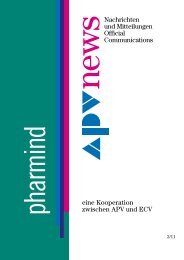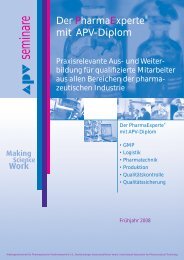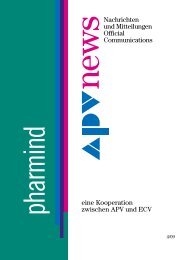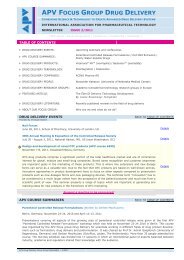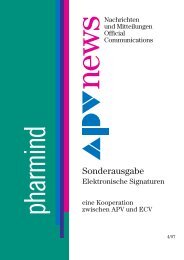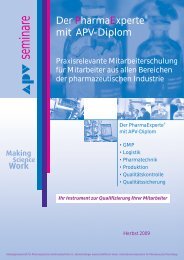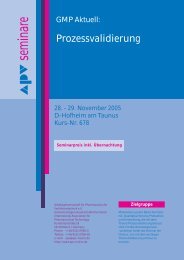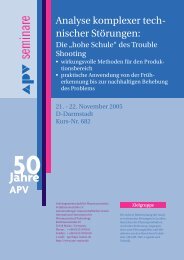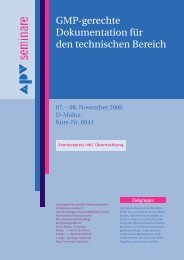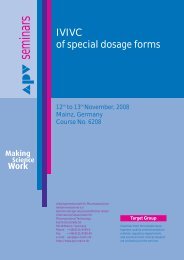New Technologies - APV
New Technologies - APV
New Technologies - APV
You also want an ePaper? Increase the reach of your titles
YUMPU automatically turns print PDFs into web optimized ePapers that Google loves.
Inhalation technology<br />
(API) to fit the inhalation drug delivery system. Smaller companies, if not<br />
specialized in inhalation drug therapy, will usually seek outside help from<br />
device manufacturers to find the best available system for their drug<br />
(Figure 4).<br />
The considerations that influence the manufacturer’s decision process<br />
when developing a DPI include dosing, performance, cost efficiency, device<br />
size, number of doses, and functionalities that can offer added value and<br />
product differentiation in terms of patient acceptability e.g. simple to use,<br />
eco-friendly, hygienic and portable (Figure 5).<br />
Figure 5: Criteria for the development of an inhaled delivery system<br />
The most popular DPI technologies are either blister or capsule based.7<br />
Both delivery systems offer comparable performance in high accuracy dosing.<br />
However, blisters rely on more cumbersome, high precision devices for<br />
their administration. The blister devices tend not to be so popular with<br />
patients and seem to be more expensive to produce compared to capsule<br />
systems [2,7]. The advantage of blister based systems may be their suitability<br />
for highly moisture-sensitive products.<br />
When the decision has been made to opt for a capsule-based system, a<br />
capsule supplier is the ideal development partner. A recent market survey<br />
found that Capsugel, the market leader in two piece capsules, was the first<br />
supplier mentioned by respondents [7]. Researchers noted that existing<br />
customers particularly appreciate the development and manufacturing<br />
support provided by Capsugel throughout the development and commercialization<br />
process that ranges from<br />
The choice of the capsule and capsule supplier is as important as the selection<br />
of the inhalation device in terms of the technological suitability, patient<br />
needs, product performance and possibilities for product differentiation<br />
(e.g. device design, capsules branding). Customisation of capsule-based<br />
inhalation systems remains the most effective way of adding value and<br />
making the product stand out from its competitors.<br />
Conclusion<br />
Inhalation technology is used extensively for the local treatment of chronic<br />
respiratory diseases such as asthma and COPD and also in other indications<br />
such as influenza or pain management that require a rapid onset of action<br />
and can be treated systemically via the lungs.<br />
The global market for pulmonary drug delivery is growing rapidly and is<br />
17 15<br />
<strong>New</strong> <strong>Technologies</strong><br />
expected to reach US $37.7 billion within the next five years with the US<br />
and Europe accounting for 75% share. There is a move away from the traditional<br />
MDIs towards newer, more sophisticated DPIs reflecting the increased<br />
research into powder formulations and innovations in particle<br />
engineering. Capsule-based devices in particular, offer many benefits to<br />
patients in terms of precise dosing, ease of use and dose visibility. The<br />
devices are hygienic to use and simple to clean and are presented in attractive<br />
designs.<br />
For manufacturers capsule-based DPI technology provides greater freedom<br />
to innovate and differentiate their products whilst benefiting from<br />
straightforward development, speed to market and efficiency in later manufacturing.<br />
In addition, capsule-based DPIs meet the practical requirements<br />
expressed by patients whilst ensuring effective treatment delivery.<br />
Nowadays, the ideal development partner for capsule systems has to offer<br />
both standardized inhaled delivery solutions for smaller pharmaceutical<br />
and generic companies or more original, tailor-made solutions for larger<br />
companies.<br />
References<br />
[1] Dry Powder Inhalation: Devices, Drugs, Therapeutics, Markets and<br />
Forecasts, Greystone Associates, July 2009<br />
[2] DPI Solutions – Overall landscape and patients’ expectations, Market<br />
Research Study by Vision Critical for Capsugel, April 2011<br />
[3] Lavorini F, Corrigan CJ, Barnes PJ, Dekhuijzen PR, Levy ML, Pedersen S,<br />
Roche N, Vincken W, Crompton GK; on behalf of The Aerosol Drug<br />
Management Improvement Team (ADMIT). Retail sales of inhalation<br />
devices in European countries: So much for a global policy. Respir<br />
Med. 2011 Jul;105(7):1099-1103.<br />
[4] Heijerman H et al. Inhaled medication and inhalation devices for lung<br />
disease in patients with cystic fibrosis: A European consensus J Cyst<br />
Fibros. 2009 Sep;8(5):295-315.<br />
[5] Media Releases: Novartis receives EU approval recommendation for<br />
TOBI® Podhaler®, a fast and simple therapy that helps reduce treatment<br />
burden for cystic fibrosis patients, September 2010 (http://<br />
www.novartis.com/newsroom/media-releases)<br />
[6] <strong>New</strong>sroom: FDA Grants Bayer HealthCare Pharmaceuticals Orphan<br />
Drug Designation for Investigational Ciprofloxacin Dry Powder Inhaler<br />
for the Treatment of Cystic Fibrosis, March 2010 (http://<br />
pharma.bayer.com)<br />
[7] DPI Solutions – Overall landscape and clients’ expectations, Market<br />
Research Study by Vision Critical for Capsugel, January 2011<br />
[8] PRWeb. Global pulmonary drug delivery technologies report. March<br />
2010



